Radioisotopes - Study guides, Class notes & Summaries
Looking for the best study guides, study notes and summaries about Radioisotopes? On this page you'll find 409 study documents about Radioisotopes.
Page 4 out of 409 results
Sort by
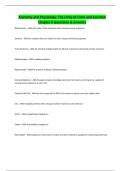
-
Anatomy and Physiology: The Unity of Form and Function Chapter 2 Questions & Answers
- Exam (elaborations) • 6 pages • 2024
- Available in package deal
-
- $12.49
- + learn more
Anatomy and Physiology: The Unity of Form and Function Chapter 2 Questions & Answers Biochemistry - ANS-the study of the molecules that compose living organisms Element - ANS-the simplest form of matter to have unique chemical properties Trace Elements - ANS-An element indispensable for life but required in extremely minute amounts. Radioisotopes - ANS-unstable isotopes Radioactivity - ANS-the process of decay of Radioisotopes Ionizing Radiation - ANS-Enough energy to dislodge electrons ...
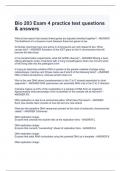
-
Bio 203 Exam 4 practice test questions & answers
- Exam (elaborations) • 7 pages • 2024
-
Available in package deal
-
- $11.99
- + learn more
What is the reason that closely linked genes are typically inherited together? - ANSWER The likelihood of a crossover event between these two genes is low All female mammals have one active X chromosome per cell instead of two. What causes this? - ANSWER Activation of the XIST gene on the X chromosome that will become the Barr body In his transformation experiments, what did Griffith observe? - ANSWER Mixing a heat-killing pathogenic strain of bacteria with a living nonpathogenic strain ca...
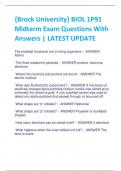
-
{Brock University} BIOL 1P91 Midterm Exam Questions With Answers | LATEST UPDATE
- Exam (elaborations) • 14 pages • 2023
-
Available in package deal
-
- $12.19
- + learn more
{Brock University} BIOL 1P91 Midterm Exam Questions With Answers | LATEST UPDATE The smallest functional unit in living organisms - ANSWER Atoms The three subatomic particles - ANSWER protons, neutrons, electrons Where the neutrons and protons are found - ANSWER The atomic nucleus What was Rutherford's experiment? - ANSWER A fine beam of positively charged alpha particles (helium nuclei) was aimed at an extremely thin sheet of gold. A zinc sulphide screen was used to detect ...
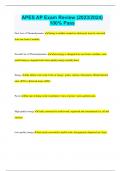
-
APES AP Exam Review (2023/2024) 100% Pass
- Exam (elaborations) • 33 pages • 2023
- Available in package deal
-
- $10.99
- + learn more
APES AP Exam Review (2023/2024) 100% Pass First Law of Thermodynamics energy is neither created nor destroyed, may be converted from one form to another. Second Law of Thermodynamics when energy is changed from one form to another, some useful energy is degraded into lower quality energy (usually heat). Energy the ability to do work. Units of energy: joules, calories, kilocalories, British thermal units (BTUs), Kilowatt-hours (kWh) Power the rate of doing work (work/time). Units of power: wat...
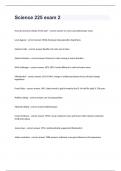
-
Science 225 exam 2 questions well answered graded A+
- Exam (elaborations) • 6 pages • 2024
- Available in package deal
-
- $12.99
- + learn more
Science 225 exam 2How do we know climate of the last? - correct answer Ice cores and sedimentary rocks Louis Agassiz - correct answer 1830s-European Alps glaciation hypothesis Glacial erratic - correct answer Boulders of rocks out of place Glacial striations - correct answer Grooves in rocks moving in same direction HMS challenger - correct answer : fossils different in cold and warm areas Milankovitch - correct answer s: change in orbital parameters forces climate change hypothes...

-
ARRT Radiography Exam Review (200-300) Questions And Answers
- Exam (elaborations) • 12 pages • 2024
- Available in package deal
-
- $11.99
- + learn more
ARRT Radiography Exam Review (200-300) Questions And Answers A ________ is used to measure radiation in an area, storage areas for radioisotopes, doses traveling through barriers, and patients who have radioactive sources within them. - ANS Handheld Ionization Chamber Handheld ionization chambers can measure exposure rates as low as ________ per hour. - ANS 10 µGyᵃ A ________ is used to detect radioactive particles in nuclear medicine facilities. - ANS Geiger-Mueller Dete...
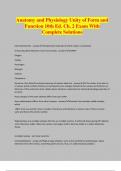
-
Anatomy and Physiology Unity of Form and Function 10th Ed. Ch. 2 Exam With Complete Solutions
- Exam (elaborations) • 11 pages • 2024
-
- $11.49
- + learn more
Anatomy and Physiology Unity of Form and Function 10th Ed. Ch. 2 Exam With Complete Solutions Chemical Element - answerFundamental materials of which matter is composed. 6 most abundant Elements in the human body - answerOCHNCP Oxygen Carbon Hyrdrogen Nitrogen Calcium Phosphorus Structure of an Atom/Functional relevance of valence electrons - answerAt the center of an atom is a nucleus which contains Protons (+) and Neutrons (no charge). Outside of the nucleus are Electrons (-). Ele...

-
BIO 161 Exam 1 Practice Questions and Correct Answers
- Exam (elaborations) • 7 pages • 2024
-
Available in package deal
-
- $8.99
- + learn more
4 levels of life cell, tissue, organ, organ system 7 characteristics of life 1. organized (composed of cells) 2. acquire materials and energy (capacity to do work and metabolize) 3. homeostatic 4. reproduce 5. potential for growth 6. have evolutionary history/heredity of traits (adapt and evolve) 7. respond to stimuli (internal or external and leads to response) Why do humans belong to the domain Eukarya and kingdom Animalia? Eukarya: because we have nuclei, organelles, a cell membrane, and an...
![[Brock University] BIOL 1P91 Midterm](/docpics/3757023/654499c63e206_3757023_121_171.jpeg)
-
[Brock University] BIOL 1P91 Midterm
- Exam (elaborations) • 9 pages • 2023
-
- $12.49
- + learn more
The smallest functional unit in living organisms - Answer- Atoms The three subatomic particles - Answer- protons, neutrons, electrons Where the neutrons and protons are found - Answer- The atomic nucleus What was Rutherford's experiment? - Answer- A fine beam of positively charged alpha particles (helium nuclei) was aimed at an extremely thin sheet of gold. A zinc sulphide screen was used to detect any alpha particles that passed through or bounced off. What shape are "s" orbitals...
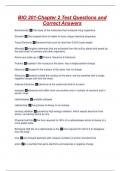
-
BIO 201-Chapter 2 Test Questions and Correct Answers
- Exam (elaborations) • 6 pages • 2024
-
Available in package deal
-
- $8.99
- + learn more
Biochemistry The study of the molecules that compose living organisms Element The simplest form of matter to have unique chemical properties Trace Elements Elements that count for less then 0.02% body weight Minerals inorganic elements that are extracted from the soil by plants and assed up the food chain to humans and other organisms. Atoms are made up of Protons, Neutrons & Electrons Protons located in the nucleus of the atom, has a single positive charge Neutrons located in the nucleus ...

That summary you just bought made someone very happy. Also get paid weekly? Sell your study resources on Stuvia! Discover all about earning on Stuvia


